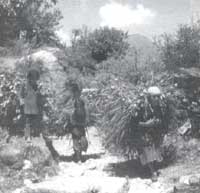Mother and nature...both?
 STUDIES on the interrelationships between gender, poverty and environmental change in rural India remain a grey area, tackled by very few economists, a notable exception being Bina Agarwal. This well-chiseled monograph focuses on variations across regions and shifts over the last two decades. It studies the impact of environmental degradation on the female members of poor rural households. This deterioration could be viewed from two angles: the appropriation of natural resources by the state and the ushering in of privatisation. To measure the gender-environment-poverty connection, the author has taken recourse to an innovative index, the gender environment and poverty (GEP) index.
STUDIES on the interrelationships between gender, poverty and environmental change in rural India remain a grey area, tackled by very few economists, a notable exception being Bina Agarwal. This well-chiseled monograph focuses on variations across regions and shifts over the last two decades. It studies the impact of environmental degradation on the female members of poor rural households. This deterioration could be viewed from two angles: the appropriation of natural resources by the state and the ushering in of privatisation. To measure the gender-environment-poverty connection, the author has taken recourse to an innovative index, the gender environment and poverty (GEP) index.
This discerning study points to an increase in the time and energy spent by women and female children - belonging to rural households, living below subsistence level - in the collection of fuel, fodder and water. What is more ominous is the drastic decline in women's income from non-timber forest products and agriculture, and the adverse effects of worsening environmental conditions on the health and nutrition of female members. The erosion of social support networks built by women and the loss of knowledge on plants are other unfortunate developments. Pre-existing gender inequalities have precipitated these trends to a large extent. They have also had a perceptible impact on the division of tabour, the intra-household distribution of subsistence resources, access to productive ' resources and women s say in public decision-making forums. But these conditions vary in form and intensity across India.
However, the author has failed to indicate whether women from the marginalised sections of society succeed in developing ecological consciousness. A parallel study conducted recently by Sandhya Venkateswaran (Environment, Development and the Gender Gap), does show that women have been denied control over their knowledge base and tabour. Affirmative action on the part of the government does not seem to have borne any fruit because women have been denied land titles. Modern management practices have hardly contributed to ensure gender equality. To the contrary, it has increasingly denied them access to resources.
The crux of the author's argument is that regions where the GEP equation is particularly cruel on women require special attention in the form of schemes which give indigent women greater control over economic resources and common property. She has also drawn attention to the fact that there is a systematic anti-female bias in the intra-household distribution of subsistence resources within rural households, as reflected by indicators like anthropometric indices, morbidity and mortality rates and sex ratio. The silver lining in the cloud seems to be the communal resources of the village which have always provided rural women and children - belonging to tribal, landless or marginal peasant households - an independent access to subsistence.
